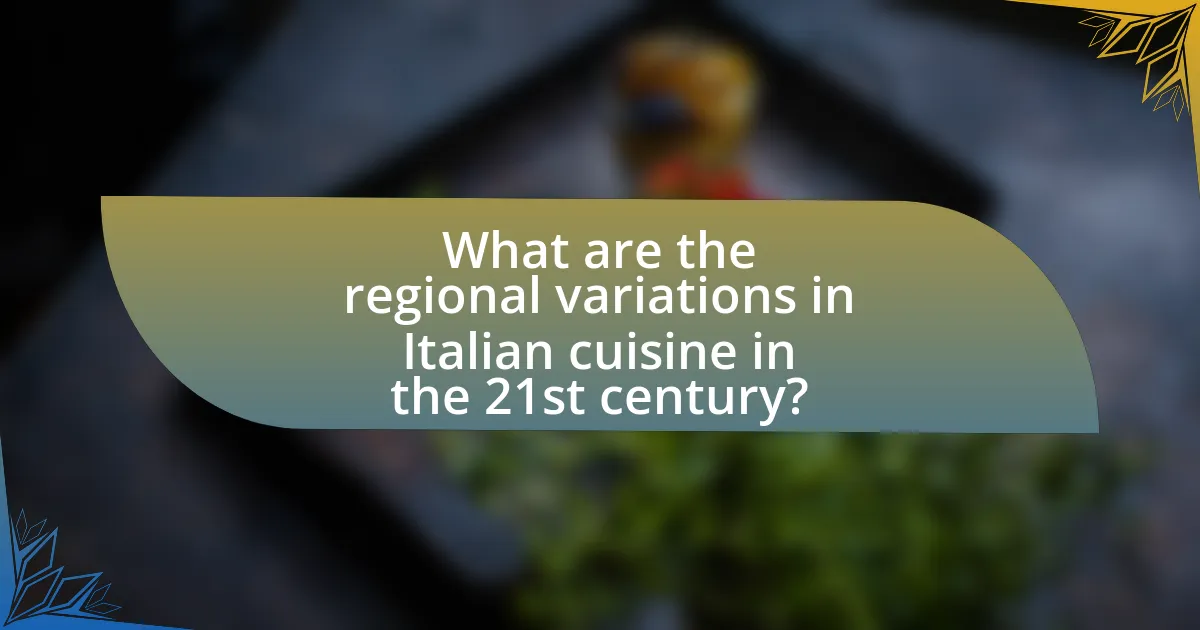The article examines the evolution of Italian cuisine in the 21st century, highlighting key characteristics such as regional diversity, sustainability, and the influence of globalization. It discusses how traditional recipes have adapted to incorporate new ingredients and health trends, as well as the role of technology in modern cooking practices. The impact of food delivery services on Italian restaurants and the emergence of fusion cuisines are also explored. Additionally, the article addresses future trends in Italian cuisine, emphasizing sustainability and plant-based cooking, while providing practical tips for home cooks to embrace contemporary Italian flavors.

What are the key characteristics of Italian cuisine in the 21st century?
Italian cuisine in the 21st century is characterized by a focus on regional diversity, sustainability, and the integration of global influences. The emphasis on regional diversity highlights the distinct culinary traditions across Italy’s various regions, showcasing local ingredients and traditional recipes. Sustainability has become increasingly important, with many chefs prioritizing organic produce and environmentally friendly practices. Additionally, the influence of global cuisines has led to innovative fusions, where traditional Italian dishes are reimagined with international flavors and techniques. This evolution reflects a broader trend towards health-conscious eating and culinary creativity, making Italian cuisine both timeless and contemporary.
How has globalization influenced Italian cuisine?
Globalization has significantly influenced Italian cuisine by introducing diverse ingredients and culinary techniques from around the world. This integration has led to the fusion of traditional Italian dishes with international flavors, resulting in innovative recipes that reflect a global palate. For instance, the incorporation of Asian spices and techniques has transformed classic Italian dishes, such as the use of soy sauce in pasta sauces or the blending of sushi elements with Italian antipasti. Additionally, the rise of global food trends, such as veganism and health-conscious eating, has prompted Italian chefs to adapt traditional recipes to meet these demands, showcasing the versatility of Italian cuisine in a global context.
What new ingredients have emerged in Italian cooking due to globalization?
New ingredients that have emerged in Italian cooking due to globalization include quinoa, avocado, and various Asian spices such as lemongrass and ginger. The incorporation of quinoa reflects a shift towards healthier, gluten-free options, while avocado has gained popularity for its creamy texture and nutritional benefits. Additionally, Asian spices have been integrated into traditional Italian dishes, enhancing flavors and creating fusion cuisine. This evolution illustrates how global culinary trends influence and diversify Italian cooking practices.
How have traditional Italian recipes adapted to international tastes?
Traditional Italian recipes have adapted to international tastes by incorporating local ingredients and flavors while simplifying preparation methods. For instance, classic dishes like pizza and pasta have seen variations that include non-traditional toppings and sauces, reflecting regional preferences outside Italy. Additionally, the rise of health-conscious eating has led to the use of whole grains, gluten-free options, and plant-based ingredients in traditional recipes. This evolution is evident in the popularity of dishes like quinoa-based pasta and cauliflower crust pizza, which cater to dietary trends while maintaining the essence of Italian cuisine.
What role does technology play in modern Italian cooking?
Technology plays a significant role in modern Italian cooking by enhancing precision, efficiency, and creativity in culinary practices. Advanced kitchen appliances, such as sous-vide machines and induction cooktops, allow chefs to achieve consistent results and control cooking temperatures with high accuracy. Additionally, digital platforms and apps facilitate recipe sharing and meal planning, enabling chefs and home cooks to explore traditional and innovative Italian dishes. The integration of technology in food sourcing, such as online grocery shopping and farm-to-table delivery services, also supports the use of fresh, high-quality ingredients, which is essential in Italian cuisine. These technological advancements collectively contribute to the evolution of Italian cooking, making it more accessible and adaptable to contemporary tastes and lifestyles.
How has the rise of food delivery services impacted Italian restaurants?
The rise of food delivery services has significantly increased the revenue and customer reach of Italian restaurants. This trend allows Italian eateries to cater to a broader audience, including those who prefer dining at home. According to a report by Statista, the online food delivery market in Italy was valued at approximately 1.5 billion euros in 2021, indicating a growing reliance on delivery services among consumers. Additionally, many Italian restaurants have adapted their menus for delivery, focusing on items that maintain quality during transport, which has led to an expansion of their offerings and enhanced customer satisfaction.
What technological innovations are changing the way Italian food is prepared?
Technological innovations such as sous-vide cooking, smart kitchen appliances, and food delivery apps are significantly changing the way Italian food is prepared. Sous-vide cooking allows for precise temperature control, enhancing the flavors and textures of traditional Italian dishes like risotto and pasta. Smart kitchen appliances, including programmable ovens and induction cooktops, streamline cooking processes and improve efficiency, enabling chefs to focus on creativity. Additionally, food delivery apps have transformed how Italian cuisine reaches consumers, making it more accessible and convenient, which has led to a rise in the popularity of regional specialties. These advancements reflect a broader trend in the culinary world, where technology enhances both the preparation and enjoyment of food.
How are health trends shaping Italian cuisine today?
Health trends are significantly shaping Italian cuisine today by promoting the use of fresh, organic ingredients and reducing reliance on processed foods. This shift is evident as more Italian restaurants and home cooks prioritize seasonal produce, whole grains, and plant-based options, aligning with global movements towards healthier eating. For instance, the rise of the Mediterranean diet, which emphasizes fruits, vegetables, legumes, and healthy fats, has reinforced traditional Italian cooking methods while adapting to modern nutritional guidelines. Additionally, studies show that 70% of Italians are now more conscious of their dietary choices, leading to a decline in red meat consumption and an increase in fish and vegetarian dishes.
What are the most popular health-conscious adaptations of traditional dishes?
The most popular health-conscious adaptations of traditional Italian dishes include whole grain pasta, cauliflower pizza crust, and zucchini noodles. Whole grain pasta offers increased fiber and nutrients compared to regular pasta, promoting better digestion and heart health. Cauliflower pizza crust significantly reduces carbohydrates and calories while providing a gluten-free option, appealing to those with dietary restrictions. Zucchini noodles, or “zoodles,” serve as a low-calorie alternative to traditional pasta, allowing for increased vegetable intake without sacrificing flavor. These adaptations reflect a growing trend towards healthier eating while maintaining the essence of Italian cuisine.
How are chefs incorporating organic and local ingredients into their menus?
Chefs are incorporating organic and local ingredients into their menus by sourcing produce from nearby farms and emphasizing seasonal offerings. This practice not only enhances the freshness and flavor of dishes but also supports local economies and reduces carbon footprints associated with transportation. For instance, many Italian chefs now collaborate with local farmers to obtain organic tomatoes, herbs, and cheeses, which are integral to traditional Italian recipes. According to a 2021 report by the Italian Ministry of Agriculture, over 30% of restaurants in Italy have adopted farm-to-table practices, showcasing a significant shift towards sustainability in the culinary landscape.

What are the regional variations in Italian cuisine in the 21st century?
Regional variations in Italian cuisine in the 21st century are characterized by distinct culinary traditions that reflect local ingredients, climate, and cultural influences. For instance, Northern Italy emphasizes rich, creamy sauces and polenta, with dishes like risotto and osso buco prevalent in Lombardy and Piedmont. In contrast, Southern Italy showcases lighter, tomato-based dishes, with pasta alla Norma and seafood being staples in Sicily and Campania.
Additionally, the use of local produce is significant; for example, the Mediterranean diet is prominent in regions like Calabria, where fresh vegetables and olive oil are central. The influence of globalization has also led to the incorporation of international flavors, particularly in urban areas, while traditional recipes continue to be preserved in rural communities. This blend of tradition and innovation illustrates the dynamic nature of Italian cuisine today.
How do different regions of Italy showcase their culinary identities?
Different regions of Italy showcase their culinary identities through distinct ingredients, traditional recipes, and cooking techniques that reflect local history and culture. For example, the northern region of Lombardy is known for its use of rice in dishes like Risotto alla Milanese, while the southern region of Campania emphasizes tomatoes and fresh seafood, evident in its famous Pizza Napoletana. Additionally, Tuscany highlights its agricultural heritage with dishes featuring olive oil and beans, such as Ribollita. Each region’s unique climate and geography influence the availability of ingredients, further solidifying their culinary identities. This regional diversity is a testament to Italy’s rich cultural tapestry, where food serves as a reflection of local customs and traditions.
What unique dishes are representative of Northern Italian cuisine?
Unique dishes representative of Northern Italian cuisine include Risotto, Polenta, and Osso Buco. Risotto, particularly Risotto alla Milanese, is characterized by its creamy texture and use of Arborio rice, often flavored with saffron. Polenta, a cornmeal dish, serves as a staple side and can be served creamy or allowed to set and sliced. Osso Buco, a braised veal shank dish, is traditionally served with gremolata and is a hallmark of Milanese cooking. These dishes reflect the region’s emphasis on rich flavors and local ingredients, showcasing the culinary diversity of Northern Italy.
How does Southern Italian cuisine differ in ingredients and flavors?
Southern Italian cuisine primarily differs from other regional Italian cuisines in its use of ingredients and flavors, emphasizing fresh vegetables, seafood, and olive oil. The cuisine often features staples like tomatoes, eggplants, and peppers, which are abundant in the region’s climate, while northern Italian cuisine tends to incorporate more dairy and meats. Additionally, Southern Italian dishes are characterized by bold flavors, often enhanced with garlic, capers, and herbs such as oregano and basil, reflecting the Mediterranean influence. This regional focus on simplicity and freshness is rooted in historical agricultural practices and local availability of ingredients, making Southern Italian cuisine distinct in its culinary identity.
What influences have immigrant communities had on Italian cuisine?
Immigrant communities have significantly influenced Italian cuisine by introducing diverse ingredients, cooking techniques, and culinary traditions. For instance, the influx of immigrants from North Africa and the Middle East has led to the incorporation of spices like cumin and coriander, which were previously less common in traditional Italian dishes. Additionally, the presence of Asian immigrants has popularized ingredients such as soy sauce and rice, leading to fusion dishes that blend Italian and Asian flavors. The adaptation of traditional recipes to include these new elements reflects the evolving nature of Italian cuisine, showcasing its ability to integrate and innovate based on cultural exchanges. This dynamic is evident in urban areas like Milan and Rome, where multicultural food markets and restaurants highlight the blending of culinary practices.
How have Italian-American dishes evolved from traditional recipes?
Italian-American dishes have evolved from traditional recipes by incorporating local ingredients, adapting cooking techniques, and reflecting American cultural influences. For instance, traditional Italian pasta dishes have been modified to include sauces like Alfredo, which is not commonly found in Italy, and the use of processed cheeses. Additionally, the introduction of ingredients such as ground beef in meatballs and the use of marinara sauce as a base for various dishes illustrate this adaptation. The evolution also includes the creation of iconic dishes like pizza, which has transformed from its Neapolitan origins to include a variety of toppings and styles, such as New York-style and Chicago deep-dish. This fusion of Italian culinary traditions with American tastes has led to a distinct Italian-American cuisine that continues to evolve.
What fusion cuisines are emerging from Italian culinary traditions?
Emerging fusion cuisines from Italian culinary traditions include Italian-Japanese, Italian-Mexican, and Italian-Indian. Italian-Japanese fusion often combines elements like sushi with Italian ingredients, such as using risotto rice in sushi rolls. Italian-Mexican fusion features dishes like pizza topped with traditional Mexican ingredients, such as chorizo or jalapeños. Italian-Indian fusion incorporates spices and cooking techniques from Indian cuisine into classic Italian dishes, resulting in offerings like masala pasta. These fusions reflect a growing trend of blending diverse culinary practices, enhancing the global appeal of Italian cuisine.

What are the future trends in Italian cuisine?
Future trends in Italian cuisine include a focus on sustainability, plant-based ingredients, and regional authenticity. As consumers become more environmentally conscious, chefs are increasingly sourcing local and organic produce, reducing food waste, and emphasizing seasonal ingredients. The rise of plant-based diets is also influencing Italian cuisine, with traditional dishes being adapted to include more vegetables, legumes, and alternative proteins. Additionally, there is a growing interest in preserving regional culinary traditions, with chefs highlighting local specialties and techniques, thereby fostering a deeper connection to Italy’s diverse gastronomic heritage. These trends reflect a broader shift towards health-conscious and environmentally sustainable eating practices in the culinary landscape.
How is sustainability impacting Italian food practices?
Sustainability is significantly influencing Italian food practices by promoting local sourcing, reducing waste, and encouraging organic farming. Italian chefs and producers are increasingly prioritizing seasonal ingredients from local farms, which not only supports the economy but also minimizes the carbon footprint associated with transportation. For instance, the Slow Food movement, founded in Italy, advocates for traditional cooking methods and the use of local ingredients, emphasizing the importance of biodiversity and sustainable agriculture. Additionally, many Italian restaurants are adopting zero-waste practices, such as utilizing all parts of ingredients and composting organic waste, which aligns with global sustainability goals. This shift towards sustainability is reshaping the culinary landscape in Italy, making it more environmentally conscious while preserving cultural heritage.
What initiatives are Italian chefs taking to promote sustainable cooking?
Italian chefs are implementing various initiatives to promote sustainable cooking, including sourcing local and seasonal ingredients, reducing food waste, and adopting eco-friendly cooking practices. For instance, many chefs collaborate with local farmers to ensure that their ingredients are fresh and sustainably produced, which supports local economies and minimizes carbon footprints. Additionally, initiatives such as the “Zero Waste” movement encourage chefs to utilize every part of an ingredient, thereby significantly reducing waste. These practices not only enhance the quality of the dishes but also align with the growing consumer demand for environmentally responsible dining options.
How are consumers responding to sustainability in Italian dining?
Consumers are increasingly prioritizing sustainability in Italian dining, demonstrating a strong preference for locally sourced ingredients and environmentally friendly practices. This shift is evidenced by a 2022 survey from the Italian National Institute of Statistics, which revealed that 70% of diners consider sustainability when choosing restaurants. Additionally, many Italian eateries are adopting organic farming methods and reducing food waste, aligning with consumer demand for transparency and ethical sourcing. This trend reflects a broader movement towards sustainable dining, as consumers seek to support businesses that contribute positively to the environment and local communities.
What innovations are chefs exploring in Italian cuisine?
Chefs are exploring innovations in Italian cuisine by incorporating modern techniques, such as sous-vide cooking and fermentation, alongside traditional ingredients. These methods enhance flavors and textures while maintaining the essence of Italian dishes. For instance, the use of molecular gastronomy allows chefs to create unique presentations and flavor combinations, such as using foams and gels derived from classic sauces. Additionally, there is a growing trend towards plant-based adaptations of traditional recipes, reflecting a shift towards sustainability and health-conscious dining. This evolution is supported by culinary schools and food research institutions that emphasize the integration of technology and sustainability in cooking practices.
How are chefs using molecular gastronomy in Italian dishes?
Chefs are using molecular gastronomy in Italian dishes by incorporating techniques such as spherification, emulsification, and foaming to create innovative textures and flavors. For example, chefs may transform traditional ingredients like balsamic vinegar into caviar-like spheres that burst with flavor, enhancing the dining experience. This approach allows for the deconstruction and reimagining of classic dishes, such as turning a Caprese salad into a visually striking presentation with mozzarella foam and tomato gel. The application of these scientific techniques not only elevates the aesthetic appeal but also introduces new sensory experiences, aligning with the contemporary evolution of Italian cuisine in the 21st century.
What role does plant-based cooking play in the future of Italian cuisine?
Plant-based cooking is poised to play a significant role in the future of Italian cuisine by promoting sustainability and health-conscious dining. As consumer preferences shift towards plant-based diets, Italian chefs are increasingly incorporating vegetables, legumes, and grains into traditional recipes, thereby modernizing classic dishes while maintaining their cultural essence. This trend is supported by data indicating that plant-based diets can reduce carbon footprints and improve public health outcomes, aligning with Italy’s commitment to sustainability and the Mediterranean diet principles. The integration of plant-based ingredients not only enhances the culinary landscape but also reflects a broader global movement towards more environmentally friendly and health-oriented food choices.
What practical tips can home cooks use to embrace modern Italian cuisine?
Home cooks can embrace modern Italian cuisine by focusing on fresh, high-quality ingredients, incorporating seasonal produce, and experimenting with traditional recipes while adding contemporary twists. Utilizing local and organic ingredients enhances flavor and supports sustainability, which is a key aspect of modern culinary practices. Additionally, home cooks should explore alternative grains like farro and quinoa, which are gaining popularity in Italian dishes, and incorporate diverse cooking techniques such as sous-vide or fermentation to elevate traditional flavors. This approach aligns with the evolving trends in Italian cuisine that emphasize innovation while respecting culinary heritage.
How can home cooks incorporate contemporary techniques into traditional recipes?
Home cooks can incorporate contemporary techniques into traditional recipes by utilizing methods such as sous-vide cooking, molecular gastronomy, and fermentation. For instance, sous-vide allows for precise temperature control, enhancing the texture and flavor of traditional dishes like risotto, which can be cooked to perfection without constant stirring. Molecular gastronomy techniques, such as spherification, can transform classic sauces into innovative presentations, adding a modern twist to familiar flavors. Additionally, fermentation can be used to create unique condiments or enhance the depth of flavor in traditional recipes, as seen in the revival of aged balsamic vinegar. These contemporary techniques not only modernize traditional Italian cuisine but also elevate the overall dining experience.
What are some easy ways to experiment with Italian flavors at home?
To experiment with Italian flavors at home, one can start by incorporating staple ingredients such as olive oil, garlic, fresh herbs like basil and oregano, and high-quality tomatoes into everyday cooking. These ingredients form the foundation of many Italian dishes and can easily enhance the flavor profile of various meals. For instance, using olive oil as a base for sautéing vegetables or drizzling it over pasta can impart a rich, authentic taste. Additionally, making a simple marinara sauce with canned San Marzano tomatoes, garlic, and herbs can provide a quick way to experience traditional Italian flavors. According to the Italian Trade Agency, the use of authentic Italian ingredients significantly contributes to the overall taste and authenticity of Italian cuisine, making these methods effective for home experimentation.















